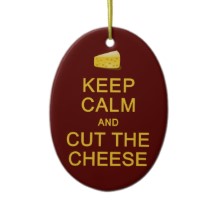Keep Calm and Cut the Cheese
Let’s face it–if something bad happens to you, you want an apology. Not just any apology, a real, genuine, honest to goodness apology. It just feels good. It feels resolved. It doesn’t make the situation better 100% of the time but it shows that someone owned up and gives a care.
Flash back: I recall a situation once in high school, I had a friend who was out sick and they asked me to take paperwork home to them from class. I ended up bringing the wrong paperwork home because I was not paying attention. And, the assignment was due the following day. Oops! I apologized profusely but my friend replied with, “Sorry doesn’t cut the cheese, Jen!”
Flash forward 5 years…er, ok, more like 7…ok fine, 12 years (gosh, I’m old) and I’m working with a customer who is having a really stinky situation in transferring their phone number over. Their original provider just wouldn’t let the number go. I was doing all I could and we finally did get the number over, but when I apologized to the customer for the delay, he said he didn’t want any “empty apologies”.
So, here I am, guilty as charged with giving cheesy, empty (holey) apologies (and suddenly craving a thick slab of Swiss cheese)…
No one is perfect. And, because of that, mistakes will be made and apologies will have to be given.
It all got me thinking, not just about a delicious cheese plate, but about how to NOT give your customers cheesy apologies. How to give them a strong, real, genuine “I’m Sorry” and mean it. Don’t give your customers cheesy canned responses when they voice their complaints. Save the cheese for the wine!
Moving forward, I want to treat each customer like they are lactose intolerant and give them each dairy free “sorry”.
Helpshift (@helpshift) created a fun document called “Dirty Words that are Driving your Customers Away“. The second dirty word is “I apologize” and to say, “I’m sorry” instead. Why? The use of the word “apologize” is quite informal and can definitely sound very generic. Saying the word “sorry” is definitely more casual and authentic. But, it’s not just what you say, it’s how you say it and the meaning behind it. Add in some creamy empathy in with your dairy free “sorry”–it smooths it out and you’re on your way. Think of what YOU would want to hear in an apology from a company. Here is one example:
“I’m very sorry that it took so long for your phone number to transfer over. I know this situation is really frustrating for you and I’m going to do all I can to make this better.”
Dairy Free Sorry Recipe
- Legit use of the word “sorry”
- Acknowledge the issue
- Empathy and connection (“I know this situation is frustrating for YOU…”)
- Fixing the issue and making it better (which includes compensation)
(Wow, I’m taken right back to our good friend, LAMB from our Feedback week).
Now, I’m going to end this post with one question for you (and don’t say “eat beans”):
How are you going to cut the cheese for your customers, when apologizing, today?
[custom_author=jenny]

Jenny, you did a great job letting your personality shine through on this one. Thanks for helping take “Sorry” to a deeper level. This is really useful.